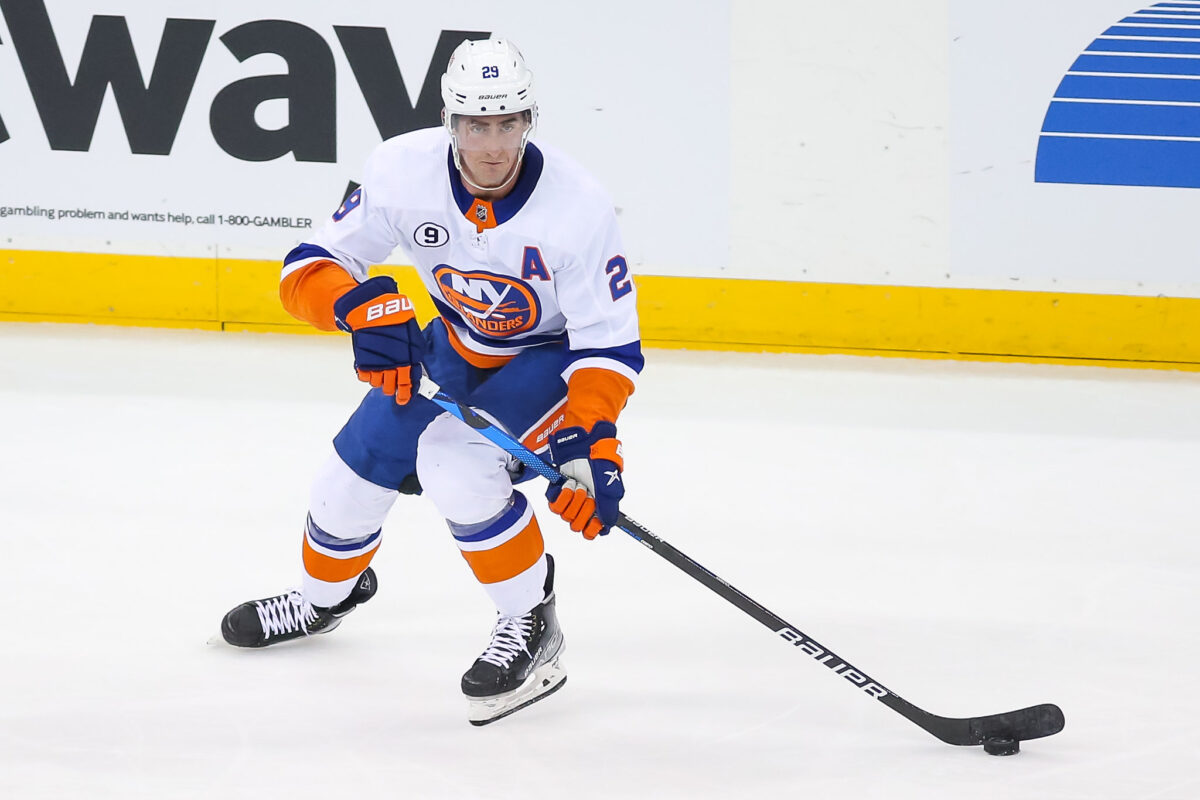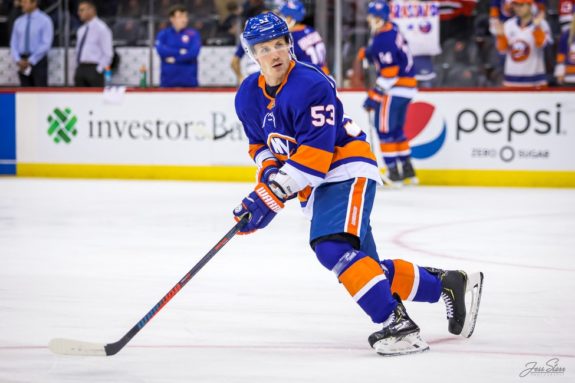It’s no secret – the New York Islanders’ forward unit, along with the offense on the whole, struggled mightily this season. Specifically, the Islanders started out the season with a hapless offense, scoring only 38 goals in the first 20 games, resulting in a 5-10-5 record, albeit mostly on the road and in the early stages of a bout with COVID-19. The forwards eventually turned a corner and stepped up in the second half of the season, largely because of the line changes. But their slow start defined the forward unit along with the team this season, leading to general manager Lou Lamoriello ensuring fans that changes to the forward group would be coming in the future. After this past season’s performance, there’s surely no blaming him for those comments, even if he did construct the roster.
Brock Nelson – Anders Lee – Anthony Beauvillier: Fink – A | Zella – A-
Fink: The combination of Brock Nelson and Anders Lee helped turn the Islanders’ offense around and more importantly, provide the team with a top line. Nelson had a career year, with a team-high 37 goals along with 22 assists, and carried his forward line. However, the veteran forward emerged this season as a complete skater both finding open skaters on the ice and finding the back of the net with quick shots in the offensive zone.
Lee meanwhile had to adjust this season but the progression allowed him to also have a great season and help lead the Islanders’ best forward line. After missing the second half of last season with a torn ACL, Lee struggled at first but once he started to find his spot in the center of the offensive zone, became a top scorer for the team, scoring 28 goals, the second-most on the team behind Nelson. Moreover, the captain started to improve as a skater in the second half of the season and became a reliable forward on the rush along with Nelson.
Anthony Beauvillier struggled, scoring only 12 goals and 22 assists in a season where he was expected to take a step forward. While Beauvillier struggled to find a role on the new line, failing to find open shots in the offensive zone or effectively carry the puck on the wing, he rounded off the top line for the Islanders. Nelson and Lee ultimately carried the Islanders’ forward unit and offense altogether, and Beauvillier failed to find a role, though didn’t set the line back.

Zella: It took a little while for Nelson and Lee to really get going, but when they did they were red hot. Reunited after a couple of seasons, they looked like they never spent any time apart. Nelson led the team in goals for the fourth straight season and Lee hit the 20-goal mark for the fifth time in the last six seasons, nearly hitting the 30-goal plateau for the third time in his career.
As Fink said, Beauvillier struggled following a great playoff run last summer. 34 points in 75 games is about the same as his production during the shortened 2019-20 season, where he collected 39 points in 68 games. His goal scoring continued to decrease this season, netting just 12 goals, the first time he’s failed to hit 15 goals since his rookie season in 2016-17. Outside of the two playoff runs, Beauvillier has simply not been a factor to the degree the Islanders need him to be.
Overall, the line played well together, and if Beauvillier isn’t included in a trade this summer, they could continue to grow together next season. They were easily the team’s best line, but that doesn’t say much considering the offense was down overall.
Zach Parise – Mathew Barzal – Oliver Wahlstrom: Fink – C+ | Zella – C
Fink: This line was defined by the skillset and talent of the young skaters in Mathew Barzal and Oliver Wahlstrom. Zach Parise finished the season with a strong year, scoring 15 goals and 20 assists, and proved once again to be an instinctive scorer, finding open shots near the net. However, the forward line was defined by the untapped potential of Barzal and Wahlstrom, who both struggled with the line change.
Related: Islanders’ Player Grades 2021-22: Defense and Goalies
Barzal is a great skater and can create open shots for the other players on the ice. Unfortunately, this season exploited some of the weaknesses in the Islanders’ top forward as he isn’t a complete forward and relies heavily on those he plays with. Barzal scored 15 goals and collected 44 assists, but the inability to find the back of the net or even shoot the puck on the net cost the 24-year-old forward this year. Wahlstrom, meanwhile, struggled to find a place on the forward unit altogether. With 13 goals and 11 assists, Wahlstrom proved he has a great shot and can find the back of the net on the wing, but he needs to play alongside a forward that can create those shots for him, something the Islanders struggled to find.

Zella: While there’s no question Barzal is the most talented player on the team, that seems to be hurting his overall production as well as the success of his line. He thinks the game at such a high level that his linemates often struggle to keep up with his decision-making and the speed at which he makes those choices. It takes a special kind of player to skate alongside elite talent, and Wahlstrom struggled to find his own footing at times, forget about keeping up with Barzal. Changes will surely be coming to this roster in the summer to help mitigate the lack of talent around Barzal.
The craziest part of this line isn’t that it didn’t meet even the lowest expectations, it’s that Parise may have been the best player. He plays a much simpler game than Barzal and Wahlstrom, more of a north-south style, but when used effectively, he can be a great addition, as he showed this season. He drives the net and, once he got the monkey off of his back, he was able to finish the season strong.
Josh Bailey – Jean-Gabriel Pageau – Kyle Palmieri: Fink – B- | Zella – B-
Fink: Jean-Gabriel Pageau and Kyle Palmieri put together respectable seasons by the end of the year. Pageau once again stepped up as a two-way center with 18 goals and 21 assists while controlling the center of the ice in the defensive zone. Likewise, Palmieri found his touch in the second half of the season, scoring 14 of his 15 goals following the NHL All-Star break, and continued to pick apart the opposing goaltenders with sharp shots. However, the forward line altogether struggled and prevented the Islanders from finding goals in their bottom-six forward lines.
Moreover, Josh Bailey struggled in a new role, playing on the same line as Pageau. Bailey is a puck distributor and finds open skaters who can finish scoring chances near the net. While Bailey finished the year with 14 goals and 30 assists playing alongside Pageau, who often carried the puck for the Islanders, he was forced to adapt and become a shooter this season. The new role benefitted the Islanders at times, but for the 32-year-old forward, it caused him to play poorly throughout the season.
Zella: There’s a lot of potential with this line, but as for this past season, they only showed a short burst of what they’re capable of. Pageau and Palmieri appear to be a great fit together; two veterans with beneficial styles and skillsets that when they’re at the top of their game, provide a great boost to the bottom six.
You’d think adding a passer like Bailey to that line would have elevated the group, but he failed to adapt in his new role, as Fink said. The Islanders needed him to shoot the puck a little more than he has in the past, and it was really difficult to watch him literally pass on opportunities to get the puck to the net. If Bailey remains on the team, it’s possible he could remain on this line, but they definitely have some kinks to work out before puck drop this October.
Cal Clutterbuck – Casey Cizikas – Matt Martin: Fink – C | Zella – C-
Fink: The “Identity Line” for lack of better words, lacked identity for a lot of the season. A large reason why was Cal Clutterbuck’s season-ending injury following the trade deadline, sidelining one of the Islanders’ best checking forwards. Clutterbuck had a strong season and started to aggressively shoot the puck on the net, providing a scoring presence to the later forward line but the upper-body injury forced head coach Barry Trotz to search for replacements throughout the season, who struggled to bring the same intensity that the 34-year-old forward provided.
While Casey Cizikas and Matt Martin continued to play well in all three zones, creating turnovers with a great forecheck and backcheck alike, the line seemed to struggle on the whole. Still, once again, the two skaters struggled to create scoring chances for a team that struggled offensively all season.

Zella: For the first time in years, this line showed their age. No longer were they a veteran line the Islanders could depend on – they looked old and slow. Even Cizikas, who for the most part continues to be the energizer bunny on both sides of the ice, didn’t look 100% this season at times.
Clutterbuck missed the end of the season with an injury, but he appeared to be struggling for most of the season. Martin, too, didn’t look himself for large chunks of the season, seemingly unable to keep up with the pace of the game. It’s disappointing on a number of levels, not the least of which was failing to be the identity the Islanders have rightfully hung on to for the last decade. It will be interesting to see what the future looks like for this line, but there’s a chance their better days are truly behind them.
Overall, the Islanders’ offense could be summed up with a C. A team with a lot of potential, even with a few missing pieces, failed to put the puck in the net with any regularity. Other lines did better than others at both ends of the ice, but there was a severe lack of energy from a team that depended on it throughout their last two playoff runs.